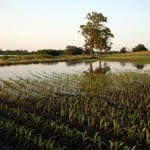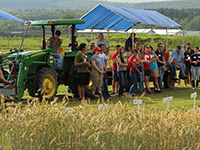Introduction | Participate | Understand | Monitor | Adapt | Mitigate | Activities | Case Studies | Links | Downloadable PDF
It’s not just thermometers telling us the climate is changing. The living world (including plants, insects, and weeds) are responding to change as well. The life cycles of insects, including the beneficial ones that keep others in check, are becoming out of sync with their prey. Pollinators, like honeybees, may already be out of sync with the plants they feed on. Earlier flowering and fruiting of plants has caused a great disconnect for some long-distance migrating birds, who depend on food availability at the same time each year.
Signs of climate change in the garden:

• Plants are leafing out and blooming earlier.
• Birds and butterflies are breeding and migrating earlier, disrupting important pollinator-to-plant connections.
• Invasive, non-native plants and animals are expanding because they are able to take advantage of weakened ecosystems and are able to out-compete native species.
• Native and iconic plants may no longer find suitable climate conditions in major portions of their historic range.
• Some plants are failing because the winter cooling period isn’t long enough, and others suffer when summer evenings are not cool enough.
• Rain events are more extreme, taking the form of longer droughts and more frequent floods.
• Longer warm periods mean more generations of some pests per year. Others are increasing their number because winters aren’t cold enough to keep them in check.
• Weedy and invasive plants like poison ivy, honeysuckle and kudzu, thrive in the presence of extra carbon dioxide, and poison ivy becomes more toxic than ever.
• Native plant populations are threatened by these changes in temperature, rainfall, pests and competitors, even the iconic ones chosen as state flowers and trees. In fact, the National Wildlife Federation predicts that 28 states will see their official plants become extinct by the end of the century.
Impacts of climate change on gardens:

• More frequent and severe weather extremes, including heat waves, droughts and floods.
• The expansion of harmful invasive species, pests and diseases.
• The disruption of ecosystems.
• The extinction of thousands of species–all of which are disasters for nature, let alone gardeners.
• Changing plant hardiness zones
(Source: The Arbor Day Foundation)
Related activities (pdfs):
• Garden Sombreros
• Arctic Tale
• Connecting with Peers in the Arctic










